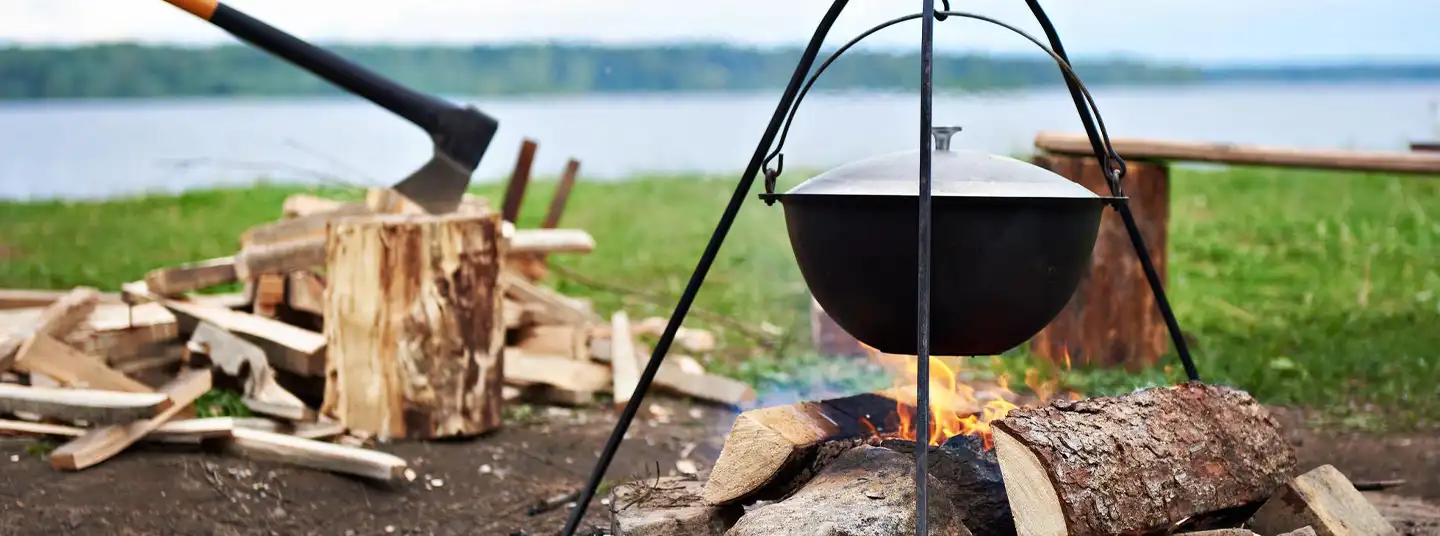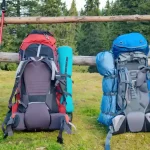

Campfire Cooking, Choosing the Right Campfire Cooking Equipment
by
Tom Miller
Choosing the right campfire cooking equipment enriches your outdoor culinary experiences. This guide explores the pros and cons of cast iron cookware, Dutch ovens, and campfire grills—each offering unique advantages for different cooking styles. Cast iron is durable and evenly distributes heat, while Dutch ovens excel in heat retention for slow cooking. Campfire grills, being lightweight and easy to clean, are ideal for grilling. Additional accessories like grill grates, griddles, and tripods further enhance campfire cooking. Proper maintenance, including regular seasoning of cast iron and Dutch ovens, ensures longevity. Whether you prefer the even heating of cast iron, the versatility of Dutch ovens, or the simplicity of grills, selecting the right equipment is key to enjoying the great outdoors.
The crackling of the campfire, the whisper of the wind through the trees, and the promise of a hearty outdoor meal—it’s the magic of camping. Central to this experience is the choice of campfire cooking equipment. The right cookware can transform a campfire into a gourmet kitchen, and among the many options available, cast iron, Dutch ovens, and grills stand out as versatile choices. In this guide, we’ll delve into these three campfire cooking staples, exploring their pros and cons, to help you make an informed decision that enhances your outdoor culinary adventures.
Cast Iron Cookware

Defining Cast Iron
Cast iron cookware has been a trusted companion of campers and outdoor enthusiasts for generations. This timeless material is revered for its durability and even heating capabilities. Cast iron pans and pots come in various shapes and sizes, making them adaptable to a wide range of campfire cooking needs.
Pros of Cast Iron for Campfire Cooking
Even Heating: Cast iron excels at distributing heat evenly across its surface. This feature is invaluable for campfire cooking, ensuring that your food cooks uniformly, without hot spots or cold corners.
Durability: Cast iron cookware is built to last. With proper care, it can withstand years of use, making it a long-term investment for outdoor cooking.
Versatility: From frying bacon to baking cornbread, cast iron can handle it all. It’s equally at home on a campfire grate or suspended over an open flame.
Easy Maintenance: While cast iron requires regular seasoning to maintain its non-stick properties, the process is straightforward and becomes second nature with experience.
Cons of Cast Iron for Campfire Cooking
Weight: The robust nature of cast iron comes with a trade-off: weight. Cast iron cookware can be heavy and bulky, which may be a consideration for backpackers and those with limited packing space.
Seasoning Requirements: Cast iron cookware needs to be seasoned regularly to maintain its non-stick surface. This involves applying a thin layer of oil and heating the cookware to create a protective coating.
Longer Heating Time: Cast iron may take longer to heat up compared to other materials, requiring patience when cooking over a campfire.
Dutch Ovens

Exploring Dutch Ovens
Dutch ovens are the workhorses of campfire cooking, deeply rooted in tradition. These heavy-duty pots, typically made of cast iron, are renowned for their ability to retain and distribute heat efficiently. Dutch ovens come in two primary types: those with legs and a flat lid for cooking over coals and those without legs and a domed lid for use with a campfire grate.
Pros of Dutch Ovens for Campfire Cooking
Excellent Heat Retention: Dutch ovens are masters of heat retention, making them ideal for slow-cooking stews, soups, and roasts.
Versatile Cooking Methods: Dutch ovens are incredibly versatile. They can roast, bake, stew, fry, and even make bread. The ability to use them on open flames or coals enhances their adaptability.
Longevity: A well-maintained Dutch oven can last for generations, making it a treasured piece of campfire cookware.
Cons of Dutch Ovens for Campfire Cooking
Heavyweight: Dutch ovens, especially larger ones, can be quite heavy. Transporting them to the campsite requires some muscle.
Seasoning Upkeep: Like other cast iron cookware, Dutch ovens need regular seasoning to maintain their non-stick surface.
Learning Curve: For beginners, Dutch ovens may have a learning curve. Achieving the perfect cooking temperature and timing requires practice.
Campfire Grills

Introducing Campfire Grills
Campfire grills offer a different approach to campfire cooking. Instead of traditional pots and pans, these grills provide an elevated platform for grilling food directly over the open flame. They are available in various designs, including tripod grills, stake grills, and adjustable grate grills.
Pros of Campfire Grills for Campfire Cooking
Lightweight: Campfire grills are typically lightweight and portable, making them an excellent choice for backpackers and campers on the move.
Easy to Clean: The open design of campfire grills makes them easy to clean. Food debris falls into the fire, reducing the need for extensive post-cooking cleanup.
Great for Grilling: If you’re a fan of grilled foods, campfire grills excel at cooking everything from burgers and hotdogs to veggies and kebabs.
Cons of Campfire Grills for Campfire Cooking
Limited Cooking Methods: Campfire grills primarily excel at grilling. If you prefer more diverse cooking methods like baking or stewing, you may need additional cookware.
May Require Additional Cookware: Depending on your menu, you might need extra cookware, such as pots and pans, to complement the grill.
Potential for Uneven Cooking: Achieving even cooking on a campfire grill can be challenging, as the distance from the flame can vary. This requires attentiveness to prevent overcooking or undercooking.
Other Campfire Cooking Accessories
Beyond the primary cookware options of cast iron, Dutch ovens, and grills, there are several additional campfire cooking accessories to consider:
- Grill Grates: Grill grates can transform an open flame into a versatile cooking surface, allowing for direct grilling and accommodating various cookware.
- Griddles: Griddles provide a flat cooking surface ideal for making pancakes, eggs, and other breakfast favorites.
- Tripods: Tripods offer a versatile way to suspend pots, kettles, or Dutch ovens over a campfire, allowing for slow, controlled cooking.
- Skewers: Skewers are perfect for roasting marshmallows, hotdogs, or kebabs over the fire.
When selecting campfire cooking equipment, consider your specific cooking needs, the campfire regulations of your chosen destination, the size of your group, and your experience level.
Maintenance and Care
Regardless of the campfire cooking equipment you choose, proper maintenance and care are essential to ensure longevity and enjoyable cooking experiences. Here are some key tips:
- Cleaning: Clean your cookware thoroughly after each use. For cast iron and Dutch ovens, avoid using soap, as it can strip away the seasoning. Instead, use a brush or scraper and hot water.
- Seasoning: Regularly season your cast iron cookware to maintain its non-stick surface and prevent rust. Apply a thin layer of cooking oil and heat the cookware to create a protective coating.
- Storage: Store your campfire cookware in a cool, dry place. If possible, keep it in a breathable bag or container to prevent moisture buildup.
Conclusion
Choosing the right campfire cooking equipment is a pivotal decision that can significantly enhance your outdoor culinary adventures. Cast iron, Dutch ovens, and campfire grills each have their unique advantages and limitations, catering to different cooking preferences and campfire styles.
Whether you opt for the even heating of cast iron, the versatility of Dutch ovens, or the simplicity of campfire grills, remember that campfire cooking is an art that rewards practice and patience. With the right equipment and a bit of culinary creativity, you can turn every campfire meal into a memorable outdoor dining experience.
So, as you plan your next camping trip, consider the heartiness of your stew, the aroma of your morning pancakes, and the sizzle of your evening barbecue. Your campfire cooking equipment is not just a set of tools; it’s your gateway to savoring the flavors of the great outdoors.
Author

Tom Miller
Tom is a seasoned camper and outdoor adventurer, with decades of experience exploring the wilderness. He's a retired park warden and has spent his life studying the flora and fauna of the natural world. Tom is a skilled outdoorsman, with a particular interest in backcountry camping, mountaineering, and wilderness survival. He's also an accomplished writer and has published several books on outdoor recreation.
Recent Posts


